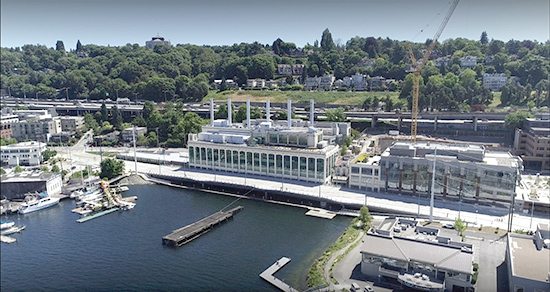|
Subscribe / Renew |
|
|
Contact Us |
|
| ► Subscribe to our Free Weekly Newsletter | |
| home | Welcome, sign in or click here to subscribe. | login |
Construction
| |
 |
February 6, 2023
National Finalist: Gold Award
Transportation

Perteet
Project: Fairview Avenue North Bridge replacement
Client: Seattle Department of Transportation
The new Fairview Avenue North Bridge, located just north of downtown Seattle along Lake Union, is a 540-foot-long prestressed concrete girder bridge replacing two bridges built 70 years ago.
As a critical link in Seattle’s transportation network, the existing bridges were no longer structurally sufficient or functionally capable of accommodating the increasing vehicular loads and non-motorized demands placed upon them. The supporting timber piles on the west bridge were decaying, and the concrete girders on the east bridge were cracking. Over 185 buses and nearly 9,000 vehicles cross the bridges daily. Pedestrians on the west side of the bridge were separated from traffic by a mountable curb. Just west of the old bridges is a floating walkway that is part of the Cheshiahud Lake Union Loop trail that was in generally good condition but had poor access from the south end.
The engineers at Perteet designed a new bridge and creatively improved the non-motorized use and access to the Cheshiahud trail and the environment around the site. The urban and congested location presented numerous construction challenges that the team worked to solve. Construction would occur in a very tight corridor with high-voltage transmission lines on one side and the ZymoGenetics building housing sensitive laboratory equipment on the other.
To mitigate geotechnical challenges encountered during design, the geotechnical and structural engineers performed extensive analysis, not typical for bridges of this magnitude. Lake Union is an essential habitat for endangered salmon, making it critical to protect the environment as part of the project.
To minimize vibration impacts to the adjacent ZymoGenetics building and to resist lateral earth pressures during a seismic event, the new bridge design included 8-foot-diameter drilled shafts that supported 3.5-foot-diameter concrete columns. Drilled shafts were installed to depths between 80 and 135 feet below the water surface to ensure that the bridge could withstand a 1,000-year seismic recurrence interval event. The proximity of the high-voltage transmission lines on one side and the buildings on the other required several special construction techniques. For example, reinforcing cages were constructed, picked, and installed in two pieces rather than the traditional single piece because of the limited room to work.
The new bridge provides two northbound lanes, one southbound lane, and facilities for pedestrians and bicyclists with several belvederes as lookouts towards Lake Union. The project design goal was to create a safe and comfortable space for all types of users. With the future in mind, the design also includes the option to add a future extension of the South Lake Union streetcar line.
The floating walkway improvements for the Cheshiahud trail provide better access and wayfinding to the walkway. New lookout points along the widened sidewalk provide secondary value to the public for appreciation of the natural beauty of Lake Union and this vibrant part of the city.
Other Stories:
- National Finalist: Platinum Award
Transportation - Best In State: Gold Award
Future Value To The Engineering Profession - Best In State: Gold Award
Social, Economic And Sustainable Design - Best In State: Gold Award
Complexity - Best In State: Gold Award
Exceeding Client/Owner Expectations - Best In State: Gold Award
Unique Or Innovative Application Of New Or Existing Techniques - National Finalist: Gold Award
Surveying/Mapping Technology - National Finalist: Gold Award
Special Projects - National Finalist: Gold Award
Structural Systems - National Finalist: Gold Award
Structural Systems - Diversity And Inclusion Award: Mid-Sized Firm
- Diversity And Inclusion Award: Large Firm
- Engineer of the Year


